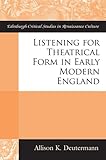Listening for Theatrical Form in Early Modern England / Allison Deutermann.
Material type: TextSeries: Edinburgh Critical Studies in Renaissance Culture : ECSRCPublisher: Edinburgh : Edinburgh University Press, [2022]Copyright date: ©2016Description: 1 online resource (208 p.) : 6 B/W illustrationsContent type:
TextSeries: Edinburgh Critical Studies in Renaissance Culture : ECSRCPublisher: Edinburgh : Edinburgh University Press, [2022]Copyright date: ©2016Description: 1 online resource (208 p.) : 6 B/W illustrationsContent type: - 9781474411264
- 9781474411271
- English drama -- Early modern and Elizabethan, 1500-1600 -- History and criticism
- English drama, Early modern and Elizabethan, 1500-1600; History and criticism
- Theater -- England -- History -- 16th century
- Theater; England; History, 16th century
- Theaters -- Sound effects
- Literary Studies
- LITERARY CRITICISM / General
- 792.0942
- PN2589 .D48 2016
- PN2589
- online - DeGruyter
- Issued also in print.
| Item type | Current library | Call number | URL | Status | Notes | Barcode | |
|---|---|---|---|---|---|---|---|
 eBook
eBook
|
Biblioteca "Angelicum" Pont. Univ. S.Tommaso d'Aquino Nuvola online | online - DeGruyter (Browse shelf(Opens below)) | Online access | Not for loan (Accesso limitato) | Accesso per gli utenti autorizzati / Access for authorized users | (dgr)9781474411271 |
Frontmatter -- Contents -- Acknowledgements -- Series Editor's Preface -- 1. Introduction: 'Audiences to this Act' -- 2. Sound in Mind and Body: Hearing Early Modern Revenge Tragedy -- 3. 'Sprinkled Among your Ears': Ben Jonson, John Marston and the Cultivation of the Listening Connoisseu -- 4. 'Caviare to the General'?: Taste, Hearing and Genre in Hamlet -- 5. Listening for Form at the Cockpit Theatre -- 6. Epilogue -- Bibliography -- Index
restricted access online access with authorization star
http://purl.org/coar/access_right/c_16ec
Examines the impact of hearing on the formal and generic development of early modern theatreEarly modern drama was in fundamental ways an aural art form. How plays should sound, and how they should be heard, were vital questions to the formal development of early modern drama. Ultimately, they shaped the two of its most popular genres: revenge tragedy and city comedy. Simply put, theatregoers were taught to hear these plays differently. Revenge tragedies by Shakespeare and Kyd imagine sound stabbing, piercing, and slicing into listeners' bodies on and off the stage; while comedies by Jonson and Marston imagine it being sampled selectively, according to taste. Listening for Theatrical Form in Early Modern England traces the dialectical development of these two genres and auditory modes over six decades of commercial theatre history, combining surveys of the theatrical marketplace with focused attention to specific plays and to the non-dramatic literature that gives this interest in audition texture: anatomy texts, sermons, music treatises, and manuals on rhetoric and poetics.Key Features Invites new attention to the theatre as something heard, rather than as something seen, in performanceProvides a model for understanding aesthetic forms as developing in competitive response to one another in particular historical circumstancesEnriches our sense of early modern playgoers' auditory experience, and of dramatists' attempt to shape it
Issued also in print.
Mode of access: Internet via World Wide Web.
In English.
Description based on online resource; title from PDF title page (publisher's Web site, viewed 02. Mrz 2022)


